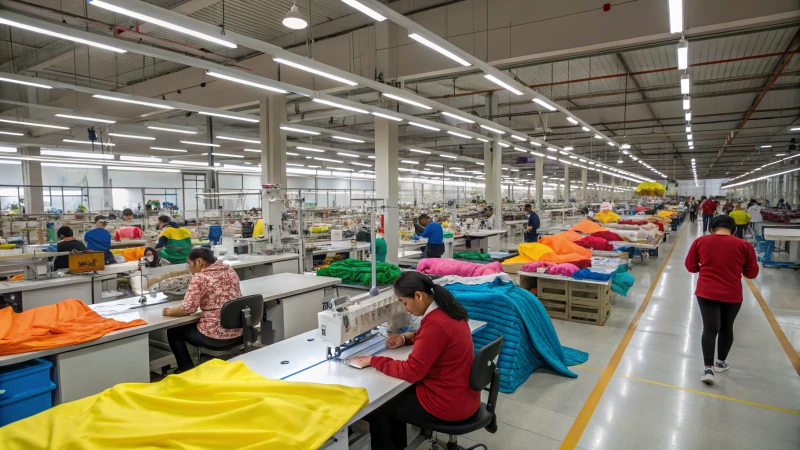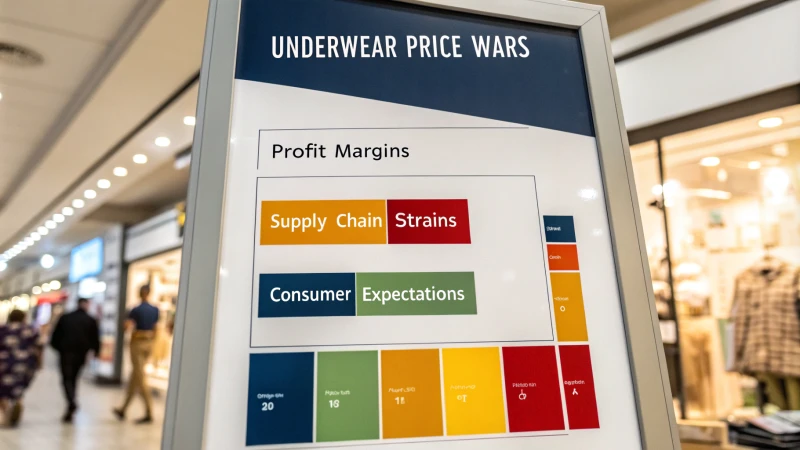
Picture yourself exploring your favorite online shop, grabbing designer underwear at a price that seems like a real deal. However, these low prices might have hidden downsides.
Underwear price wars affect the economy in many ways. These battles reduce profit margins. They very often put pressure on supply chains. They also set consumer expectations for very low prices. Innovations probably suffer as a result.
Let's explore more deeply. These appealing discounts often change the market. They impact shopping habits and can affect global economic trends. It's a domino effect. A great bargain today might reduce choices and stifle innovation in the future. It's like hoping for a gourmet meal each time you eat out, but the menu shrinks and loses flavor. Pricing battles shape the economic landscape.
Underwear price wars stifle innovation in the industry.True
Price wars reduce profit margins, limiting funds for research and development.
Price wars lead to increased global economic indicators.False
Price wars typically lower profits and may negatively impact economic growth.
What are the immediate benefits and drawbacks of price wars?
Remember the time when a big sale happened and you felt like you found treasure? That's the charm of price fights! But what occurs behind the scenes in these battles?
Price wars give consumers instant savings. These discounts elevate market competitiveness. Profit margins reduce as a result. Supply chains face considerable strain. Quality and innovation might suffer. Industry growth may really slow down.
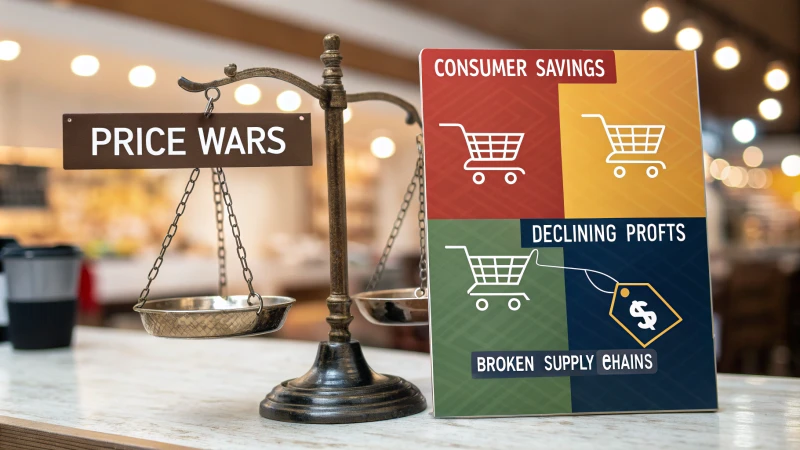
Benefits of Price Wars
I remember getting an amazing deal on a new gadget during a price war. It really felt like winning the lottery. Price wars give us shoppers immediate benefits by cutting prices, making everything seem more affordable. Brands enter these battles to grab a bigger share of the market, which is particularly helpful during tough economic periods1.
Table: Immediate Benefits of Price Wars
| Benefit | Description |
|---|---|
| Increased Affordability | Consumers access products at lower prices. |
| Enhanced Market Competition | Drives brands to innovate in marketing strategies. |
| Expanded Market Share | Brands can attract more customers quickly. |
These benefits seem like a dream come true but are often short-lived and come with significant drawbacks.
Drawbacks of Price Wars
Businesses often struggle when profits fall during these fights. As prices drop, brands earn less from each sale, putting smaller companies in a difficult situation. This often leads to cost-cutting measures2 that compromise product quality or labor conditions.
Table: Immediate Drawbacks of Price Wars
| Drawback | Description |
|---|---|
| Shrinking Profit Margins | Lower earnings per sale impact financial stability. |
| Supply Chain Strain | Forces reductions in quality and labor standards. |
| Consumer Expectation Shift | Low prices become the norm, hindering future increases. |
Price wars sometimes stifle innovation as companies cut budgets for research and development, slowing down the industry and stopping it from bringing us new products.
Engaging in price wars means brands risk filling the market with too much stock, leading to waste and inefficiency. This might push smaller competitors out, reducing consumer choice and potentially leading to monopolistic scenarios3.
Next time you find a great deal during one of these price battles, think about the larger effects of those reduced prices.
Price wars increase consumer product affordability.True
Price wars lower product prices, making them more accessible to consumers.
Price wars enhance long-term industry innovation.False
Prolonged price wars reduce R&D budgets, stifling innovation in the industry.
How Do Price Wars Influence Supply Chain Dynamics?
Did you ever think about how a small price decrease affects a whole industry? It very likely changes supply chains. It also reshapes business activities.
Price wars influence how supply chains function by reducing profits. These price battles affect relationships with suppliers. They put more pressure on controlling costs. This situation results in problems with operations. Product quality may also suffer because of this.

Impact on Profit Margins and Supplier Relationships
I recall my first experience with a price war in the fashion industry. It resembled a chess game where everyone raced to win by lowering prices. Initially, it felt thrilling - everyone loves a bargain! But soon, the excitement faded into a harsh reality for many brands. Price wars really hurt profit margins, leaving companies struggling to survive. Smaller brands often suffer the most, barely managing to cope with these challenges. This struggle is often very intense.
One memorable story involves my friend who owns a boutique clothing line. During a fierce price war, suppliers were asked for cost cuts. I remember their frustration when compromises on material quality became necessary. This decision caused many customer complaints about poor fabric quality. It haunted them later.
| Factor | Impact |
|---|---|
| Reduced Profits | Less reinvestment in R&D |
| Supplier Strain | Potential quality compromises |
Consumer Expectations and Market Saturation
Price wars also shape consumer expectations. When prices stay low for a long time, people consider it normal. They start thinking that if one brand offers a low price, others should too. Brands end up stuck in a cycle of low prices and thin margins. Raising prices later risks losing customers.
This cycle often brings market saturation. Companies overproduce, trying to offset low prices with higher volumes. But usually, it backfires, resulting in excess inventory that's hard to sell without more discounts. It creates a vicious cycle of reduced profits and possible waste.
Effects on Innovation and Competition
Another unfortunate result of price wars is how they limit innovation. Tight budgets due to low profit margins push research and development aside. I've observed slower progress in areas like sustainable materials and innovative designs.
Smaller competitors face tough times, unable to match continuous price cuts. The competition shrinks, offering fewer choices for consumers.
Explore how price strategies affect innovation4 for more insights into this dynamic.
Price wars lead to strained supplier relationships.True
Suppliers face pressure to cut costs, affecting quality and relationships.
Price wars increase innovation in the industry.False
Reduced profits limit R&D investment, stifling innovation efforts.
How Do Price Wars Impact Innovation in the Underwear Industry?
Have you ever thought about how a price war could stop creativity? When underwear companies fight over prices, new ideas might really suffer. Let's explore this interesting puzzle.
Price wars probably cause innovation stagnation in the underwear industry. They take away resources from research and development. Companies may not invest in new materials, designs and sustainable practices.
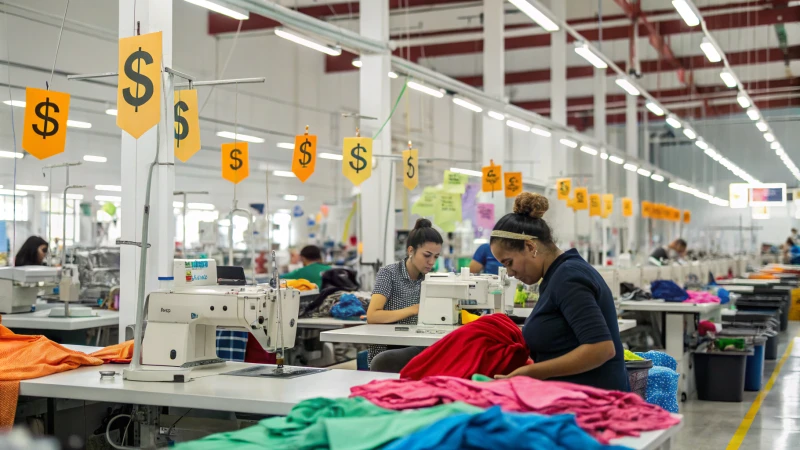
The Economic Impact of Price Wars on Innovation
Sometimes fierce competition resembles a double-edged sword. When I entered the underwear industry, price wars seemed great for consumers at first. However, these battles also brought hidden costs. Brands lower their prices to outdo each other. This rivalry often leaves little space for creativity, which many of us loved in fashion.
Profit Margin Squeeze
During these price battles, companies often reduce new ideas and technology trials because of tight budgets. This financial pressure effectively limits innovation. Many firms become careful and avoid risks.
Case Study: Impact on Smaller Brands
I once spoke with a small brand owner passionate about new designs. During a brutal price war, they were forced to close down. Competitive pressure eliminated any chance for experimentation or fresh ideas.
| Brand Type | Innovation Potential Before | Innovation Potential After |
|---|---|---|
| Large Brands | Moderate | Low |
| Medium Brands | High | Moderate |
| Small Brands | Very High | Non-existent |
Supply Chain Strain and Quality Compromise
Price wars frequently result in cut corners within the supply chain. I witnessed suppliers cope under pressure by reducing quality and labor conditions, which restricts brands from innovating sustainably. Eco-friendly materials often become an unaffordable luxury instead of a standard choice.
Sustainability Challenges
Price wars shift focus from vital eco-friendly actions. Consumers sometimes want greener products, but tight budgets make fulfilling these demands challenging. As someone who values sustainability, I feel disappointed by this situation.
| Supplier Aspect | Pre-Price War State | Post-Price War State |
|---|---|---|
| Material Quality | High | Variable |
| Labor Conditions | Stable | Compromised |
| Innovation Funding | Available | Limited |
Consumer Expectations and Long-term Effects
Price wars make consumers expect low prices, which complicates justifying premium prices for innovation. Many brand owners I know face this difficulty in balancing customer expectations with creative goals.
The Future of Consumer Behavior
I found that consumers become less interested in innovative products when they expect low prices. This trend strongly influences brands planning to release new items.
Looking back on these experiences, it becomes clear that while price wars seem helpful initially, they pose huge challenges to innovation in the underwear industry. Probably, brands need an effective balance between keeping prices competitive and investing in innovation5.
Price wars reduce innovation in the underwear industry.True
Reduced profit margins limit funds for R&D, stifling innovation.
Price wars improve material quality in underwear production.False
Lower supplier prices often lead to a decline in material quality.
What Are the Long-Term Market Consequences of Price Wars?
Think of a world where prices constantly fall. Beneath this, a ripple effect changes entire industries.
Price wars often lead to reduced profit margins. Supply chains become strained. Market innovation also suffers. Over time, consumers start expecting low prices. Brands might struggle to stay profitable. It's really hard for them to keep profits high.
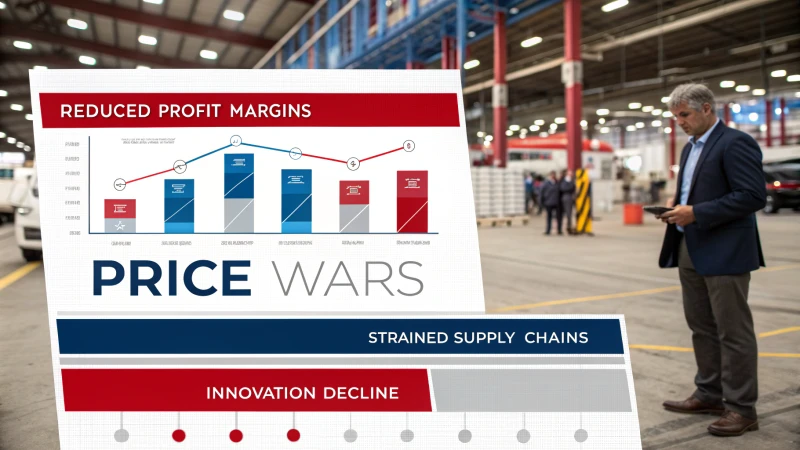
Shrinking Profit Margins and Market Exit
There was a time when I felt thrilled by a crazy price war. Prices dropped everywhere! Then I noticed that big brands often survive such storms. Smaller or niche brands struggle, really. Entrepreneurs pour their passion into unique brands but then face market exit as profits dwindle. Fewer choices exist for shoppers. This is unfortunate, leading to market exit6.
Strain on Supply Chains
It feels like watching dominoes fall one by one. Lower prices push suppliers to compromise. Quality suffers in materials and labor. I heard from a supplier once; they had to let talented craftsmen go just to save money. The strain likely ruins relationships, impacting product quality and affecting the industry supply chain7.
Consumer Expectations and Price Elasticity
Have you noticed how raising prices after a sale irritates customers? It’s difficult because price wars teach shoppers to expect low prices all the time. Brands find it nearly impossible to adjust prices later, impacting long-term price elasticity8 and profits.
Innovation Stagnation
Surviving price wars drains resources from innovation. Imagine having groundbreaking ideas but no funds to bring them to life—it’s disheartening. This stagnation halts industry progress as budgets for R&D shrink, limiting technological advancements9.
Market Saturation and Overproduction
To deal with skimpy margins, brands churn out more products, resulting in surplus inventory cluttering warehouses. This scenario can start endless discounting cycles where more products flood the market.
| Impact | Description |
|---|---|
| Market Saturation | Surplus inventory clutters warehouses |
| Overproduction | More products flood the market |
| Heavy Discounting | Cycles leading to further market saturation |
A closer look at these scenarios shows how price wars affect the market ecosystem at every level.
Price wars lead to shrinking profit margins.True
Brands lower prices to compete, reducing their profit margins.
Innovation increases during price wars.False
Budgets for R&D shrink as brands allocate resources to survive.
Conclusion
Underwear price wars create short-term consumer benefits but lead to reduced profit margins, strained supply chains, stifled innovation, and altered consumer expectations, ultimately harming the economy.
Understand how price wars help consumers during tough economic times by offering lower prices. ↩
Learn about how brands' cost-cutting during price wars can degrade product quality. ↩
Explore how excess inventory from price wars leads to waste and reduced competition. ↩
Learn about the relationship between aggressive pricing strategies and innovation in product development. ↩
Explore strategies for maintaining innovation amid competitive pricing pressures. ↩
Explore how price wars affect smaller brands and why they may struggle against larger competitors. ↩
Understand how price wars strain supply chains and affect product quality. ↩
Learn how prolonged price reductions change consumer behavior and expectations. ↩
Discover how price wars limit budgets for R&D, affecting innovation. ↩



